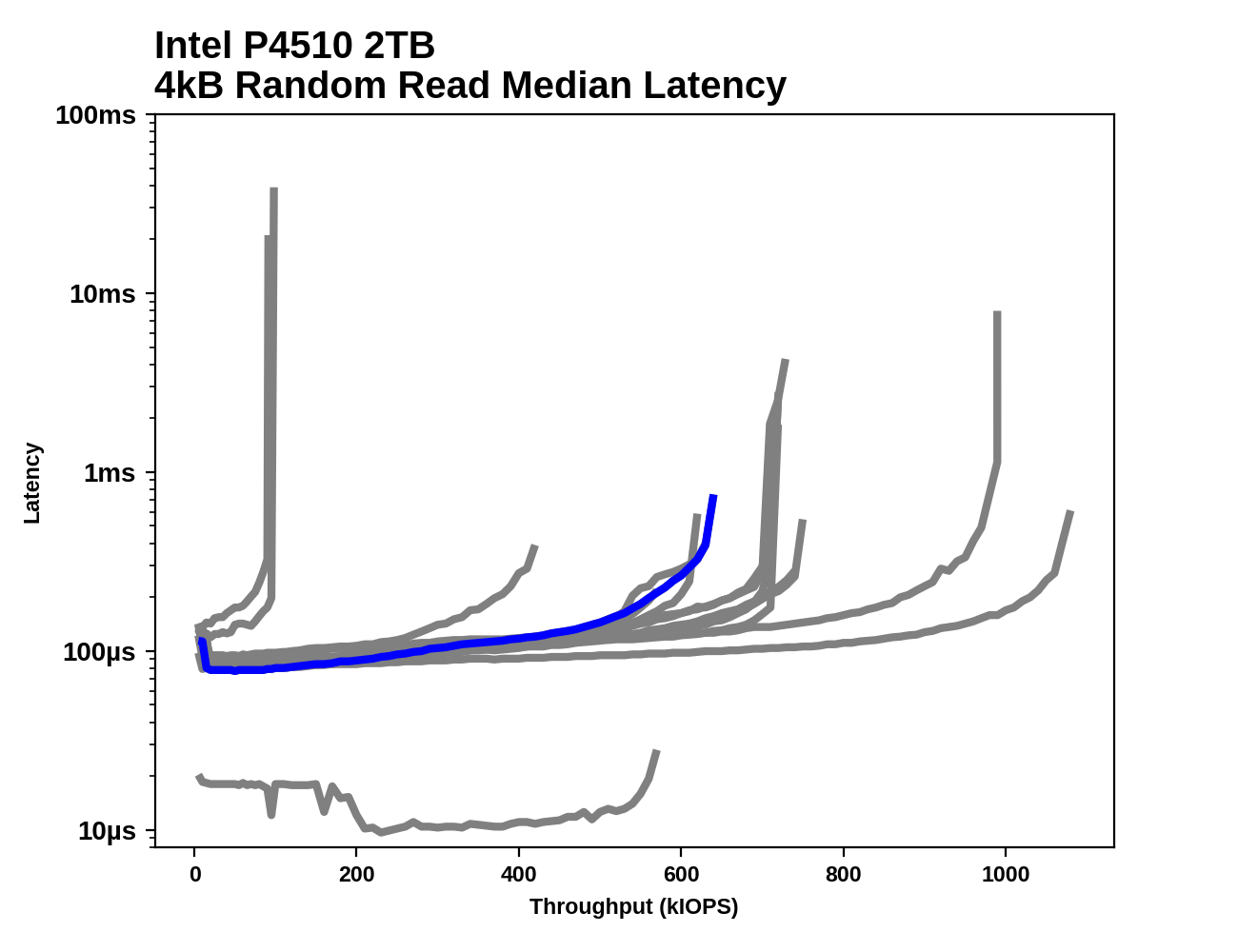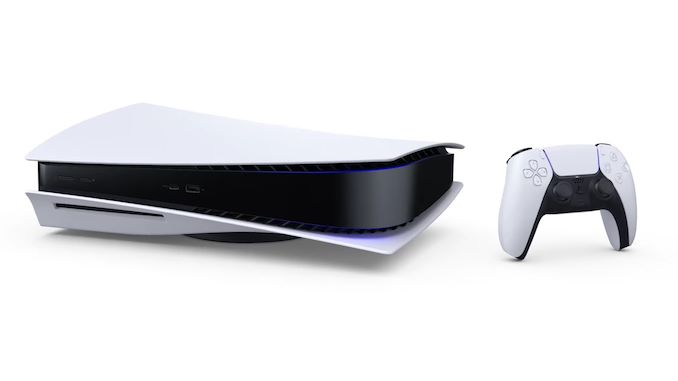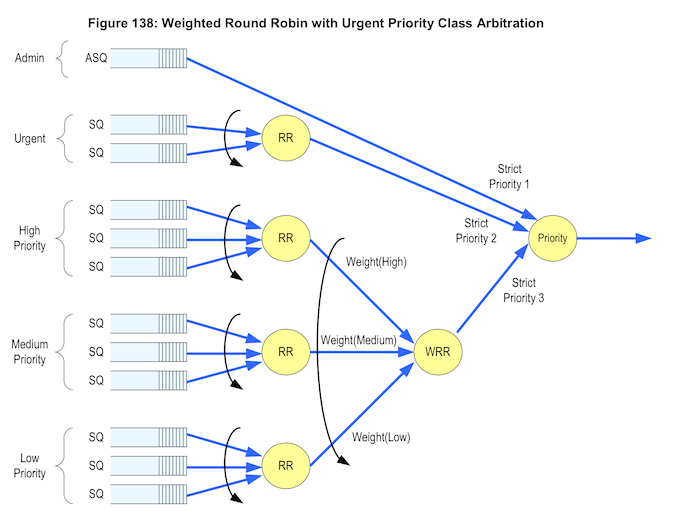Storage Matters: Why Xbox and Playstation SSDs Usher In A New Era of Gaming
by Billy Tallis on June 12, 2020 9:30 AM EST- Posted in
- SSDs
- Storage
- Microsoft
- Sony
- Consoles
- NVMe
- Xbox Series X
- PlayStation 5
What's Necessary to Get Full Performance Out of a Solid State Drive?
The storage hardware in the new consoles opens up new possibilities, but on its own the hardware cannot revolutionize gaming. Implementing the new features enabled by fast SSDs still requires software work from the console vendors and game developers. Extracting full performance from a high-end NVMe SSD requires a different approach to IO than methods that work for hard drives and optical discs.
We don't have any next-gen console SSDs to play with yet, but based on the few specifications released so far we can make some pretty solid projections about their performance characteristics. First and foremost, hitting the advertised sequential read speeds will require keeping the SSDs busy with a lot of requests for data. Consider one of the fastest SSDs we've ever tested, the Samsung PM1725a enterprise SSD. It's capable of reaching over 6.2 GB/s when performing sequential reads in 128kB chunks. But asking for those chunks one at a time only gets us 680 MB/s. This drive requires a queue depth of at least 16 to hit 5 GB/s, and at least QD32 to hit 6 GB/s. Newer SSDs with faster flash memory may not require queue depths that are quite so high, but games will definitely need to make more than a few requests at a time to keep the console SSDs busy.
The consoles cannot afford to waste too much CPU power on communicating with the SSDs, so they need a way for just one or two threads to manage all of the IO requests and still have CPU time left over for those cores to do something useful with the data. That means the consoles will have to be programmed using asynchronous IO APIs, where a thread issues a read request to the operating system (or IO coprocessor) but goes back to work while the request is being processed. And the thread will have to check back later to see if a request has been fulfilled. In the hard drive days, such a thread would go off and do several non-storage tasks while waiting for a read operation to complete. Now, that thread will have to spend that time issuing several more requests.
In addition to keeping queue depths up, obtaining full speed from the SSDs will require doing IO in relatively large chunks. Trying to hit 5.5 GB/s with 4kB requests would require handling about 1.4M IOs per second, which would strain several parts of the system with overhead. Fortunately, games tend to naturally deal with larger chunks of data, so this requirement isn't too much trouble; it mainly means that many traditional measures of SSD performance are irrelevant.
Microsoft has said extremely little about the software side of the Xbox Series X storage stack. They have announced a new API called DirectStorage. We don't have any description of how it works or differs from existing or previous console storage APIs, but it is designed to be more efficient:
DirectStorage can reduce the CPU overhead for these I/O operations from multiple cores to taking just a small fraction of a single core.
The most interesting bit about DirectStorage is that Microsoft plans to bring it to Windows, so the new API cannot be relying on any custom hardware and it has to be something that would work on top of a regular NTFS filesystem. Based on our experiences testing fast SSDs under Windows, they could certainly use a lower-overhead storage API, and it would be applicable to far more than just video games.
Sony's storage API design is probably intertwined with their IO coprocessors, but it's unlikely that game developers have to be specifically aware that their IO requests are being offloaded. Mark Cerny has stated that games can bypass normal file IO, elaborated a bit in an interview with Digital Foundry:
There's low level and high level access and game-makers can choose whichever flavour they want - but it's the new I/O API that allows developers to tap into the extreme speed of the new hardware. The concept of filenames and paths is gone in favour of an ID-based system which tells the system exactly where to find the data they need as quickly as possible. Developers simply need to specify the ID, the start location and end location and a few milliseconds later, the data is delivered. Two command lists are sent to the hardware - one with the list of IDs, the other centring on memory allocation and deallocation - i.e. making sure that the memory is freed up for the new data.
Getting rid of filenames and paths doesn't win much performance on its own, especially since the system still has to support a hierarchical filesystem API for the sake of older code. The real savings come from being able to specify the whole IO procedure in a single step instead of the application having to manage parts like the decompression and relocating the data in memory—both handled by special-purpose hardware on the PS5.
For a more public example of what a modern high-performance storage can accomplish, it's worth looking at the io_uring asynchronous API added to Linux last year. We used it on our last round of enterprise SSD reviews to get much better throughput and latency out of the fastest drives available. Where old-school Unix style synchronous IO topped out at a bit less than 600k IOPS on our 36-core server, io_uring allowed a single core to hit 400k IOPS. Even compared to the previous asynchronous IO APIs in Linux, io_uring has lower overhead and better scalability. The API's design has applications communicating with the operating system in a very similar manner to how the operating system communicates with NVMe SSDs: pairs of command submission and completion queues that are accessible by both parties. Large batches of IO commands can be submitted with at most one system call, and no system calls are needed to check for command completion. That's a big advantage in a post-Spectre world where system call overhead is much higher. Recent experimentation has even shown that the io_uring design allows for shader programs running on a GPU to submit IO requests with minimal CPU involvement.
Most of the work relating to io_uring on Linux is too recent to have influenced console development, but it still illustrates a general direction that the industry is moving toward, driven by the same needs to make good use of NVMe performance without wasting too much CPU time.
Keeping Latency Under Control
While game developers will need to put some effort into extracting full performance from the console SSDs, there is a competing goal. Pushing an SSD to its performance limits causes latency to increase significantly, especially if queue depths go above what is necessary to saturate the drive. This extra latency doesn't matter if the console is just showing a loading screen, but next-generation games will want to keep the game running interactively while streaming in large quantities of data. Sony has outlined their plan for dealing with this challenge: their SSD implements a custom feature to support 6 priority levels for IO commands, allowing large amounts of data to be loaded without getting in the way when a more urgent read request crops up. Sony didn't explain much of the reasoning behind this feature or how it works, but it's easy to see why they need something to prioritize IO.

Loading a new world in 2.25 seconds as Ratchet & Clank fall through an inter-dimensional rift
Mark Cerny gave a hypothetical example of when multiple priority levels are needed: when a player is moving into a new area, lots of new textures may need to be loaded, at several GB per second. But since the game isn't interrupted by a loading screen, stuff keeps happening, and an in-game event (eg a character getting shot) may require data like a new sound effect to be loaded. The request for that sound effect will be issued after the requests for several GB of textures, but it needs to be completed before all the texture loading is done because stuttering sound is much more noticeable and distracting than a slight delay in the gradual loading of fresh texture data.
But the NVMe standard already includes a prioritization feature, so why did Sony develop their own? Sony's SSD will support 6 priority levels, and Mark Cerny claims that the NVMe standard only supports "2 true priority levels". A quick glance at the NVMe spec shows that it's not that simple:
The NVMe spec defines two different command arbitration schemes for determining which queue will supply the next command to be handled by the drive. The default is a simple round-robin balancing that treats all IO queues equally and leaves all prioritization up to the host system. Drives can also optionally implement the weighted round robin scheme, which provides four priority levels (not counting one for admin commands only). But the detail Sony is apparently concerned with is that among those four priority levels, only the "urgent" class is given strict priority over the other levels. Strict prioritization is the simplest form of prioritization to implement, but such methods are a poor choice for general-purpose systems. In a closed specialized system like a game console it's much easier to coordinate all the software that's doing IO in order to avoid deadlocks and starvation. much of the IO done by a game console also comes with natural timing requirements.
This much attention being given to command arbitration comes as a bit of a surprise. The conventional wisdom about NVMe SSDs is that they are usually so fast that IO prioritization is unnecessary, and wasting CPU time on re-ordering IO commands is just as likely to reduce overall performance. In the PC and server space, the NVMe WRR command arbitration feature has been largely ignored by drive manufacturers and OS vendors—a partial survey of our consumer NVMe SSD collection only turned up two brands that have enabled this feature on their drives. So when it comes to supporting third-party SSD upgrades, Sony cannot depend on using the WRR command arbitration feature. This might mean they also won't bother to use it even when a drive has this feature, instead relying entirely on their own mechanism managed by the CPU and IO coprocessors.
Sony says the lack of six priority levels on off the shelf NVMe drives means they'll need slightly higher raw performance to match the same real-world performance of Sony's drive because Sony will have to emulate the 6 priority levels on the host side, using some combination of CPU and IO coprocessor work. Based on our observations of enterprise SSDs (which are designed with more of a focus on QoS than consumer SSDs), holding 15-20% of performance in reserve typically keeps latency plenty low (about 2x the latency of an idle SSD) without any other prioritization mechanism, so we project that drives capable of 6.5GB/s or more should have no trouble at all.
 |
Latency spikes as drives get close to their throughput limit
It's still a bit of a mystery what Sony plans to do with so many priority levels. We can certainly imagine a hierarchy of several priority levels for different kinds of data: Perhaps game code is the highest priority to load since at least one thread of execution will be completely stalled while handling a page fault, so this data is needed as fast as possible (and ideally should be kept in RAM full-time rather than loaded on the fly). Texture pre-fetching is probably the lowest priority, especially fetching higher-resolution mimpaps when a lower-resolution version is already in RAM and usable in the interim. Geometry may be a higher priority than textures, because it may be needed for collision detection and textures are useless without geometry to apply them to. Sound effects should ideally be loaded with latency of at most a few tens of milliseconds. Their patent mentions giving higher priority to IO done using the new API, on the theory that such code is more likely to be performance-critical.
Planning out six priority classes of data for a game engine isn't too difficult, but that doesn't mean it will actually be useful to break things down that way when interacting with actual hardware. Recall that the whole point of prioritization and other QoS methods is to avoid excess latency. Excess latency happens when you give the SSD more requests than it can work on simultaneously; some of the requests have to sit in the command queue(s) waiting their turn. If there are a lot of commands queued up, a new command added at the back of the line will have a long time to wait. If a game sends the PS5 SSD new requests at a rate totaling more than 5.5GB/s, a backlog will build up and latency will keep growing until the game stops requesting data more quickly than the SSD can deliver. When the game is requesting data at much less than 5.5GB/s, every time a new read command is sent to the SSD, it will start processing that request almost immediately.
So what's most important is limiting the amount of requests that can pile up in the SSD's queues, and once that problem is solved, there's not much need for further prioritization. It should only take one queue to put all the background, latency-insensitive IO commands into to be throttled, and then everything else can be handled with low latency.
Closing Thoughts
The transition of console gaming to solid state storage will change the landscape of video game design and development. A dam is breaking, and game developers will soon be free to ignore the limitations of hard drives and start exploring the possibilities of fast storage. It may take a while for games to fully utilize the performance of the new console SSDs, but there will be many tangible improvements available at launch.
The effects of this transition will also spill over into the PC gaming market, exerting pressure to help finally push hard drives out of low-end gaming PCs, and allowing gamers with high-end PCs to start enjoying more performance from their heretofore underutilized fast SSDs. And changes to to the Windows operating system itself are already underway because of these new consoles.
Ultimately, it will be interesting to see whether the novel parts of the new console storage subsystems end up being a real advantage that influences the direction of PC hardware development, or if they end up just being interesting quirks that get left in the dust as PC hardware eventually overtakes the consoles with superior raw performance. NVMe SSDs arrived at the high end of the consumer market five years ago. Now, they're crossing a tipping point and are well on the way to becoming the mainstream standard for storage.













200 Comments
View All Comments
JStacts - Tuesday, June 30, 2020 - link
"The problem is that upgrading is a necessity." Upgrading a computer is no more necessary that buying a new console (I would argue less). The difference is that the PC game can upgrade when he wants and is not forced into a cycle by a multi-national corporation. I built my computer a few years ago with an RX480. Could I upgrade? Sure. I could have upgraded last year, or the year before. I could upgrade next year.It is entirely my choice when or even if I upgrade. It is my choice how much to spend on the upgrade. It is my choice because of the incredible wealth of options offered by the PC market.
If I had a PS4, I had to wait until Sony CHOSE to release the Pro version (which they had no obligation to do) or the PS5.
Next year, I will very probably buy a couple monitors and upgrade my GPU, but I certainly don't feel compelled to do so. I enjoy my gaming experience.
It is this difference of choice that makes my say that "I get to upgrade" instead of "I have to upgrade".
You mentioned that we (PC gamers) spend thousands to keep up with the state of software. While there certainly are those people (and you will meet a disproportionate number of them in the AT comment section), I would hardly call that a fair generalization of the PC gaming community. Most of us keep our components for many years before upgrading. Most of us are perfectly happy buying low or midrage parts and the gaming experiences those offer. A significant portion of us use very low end hardware.
If you're not already acquainted with the channel, I recommend "The LowSpec Gamer" on Youtube. His entire channel is dedicated to making AAA games run on extremely low-end hardware.
Oxford Guy - Monday, June 15, 2020 - link
"What makes a console a good piece of hardware is that I do not have to even care what is inside the box that runs the games since the games that I buy for said console will just work as intended. Every generation has extensive discussion about hardware and the usual comparing and penis measuring between brands. It all ends up being meaningless when you pick up a controller and play a game on it which is far and above the hassle of PC gaming in terms of equipment apathy. In short, IDGAF what drive is inside the thing. Insert disc (or download digital copy) and game on!"Thank you MS or Sony employee for this attempt to justify the "console" scam.
zmatt - Tuesday, June 16, 2020 - link
Adding internal storage and internet connectivity destroyed what I saw as the two big advantages with consoles. It used to be that you didn't have to install anything and you didn't have to patch anything. Developers were forced to released games as complete and working products and playing them was truly as simple as sticking a disc in and playing.Sure load times and graphics suffered because of it but consoles shouldn't try to compete with PCs on performance anyways. Its a fool's errand. Back then you could truly say consoles just worked. Having to wait for games to install, having to manage updates and dealing with buggy releases were largely problems that PC users had to put up with.
Now consoles have all of those problems too. You can't seem to power on a console today without first waiting for it to update before letting you do anything. And unlike on a PC where you have control of such things the console will force you to update both it and the games before letting you play them. The only way around it is to disconnect networking entirely which renders half of its functionality broken.
If I can't just slap in a disc and play then why bother? If I have to expend effort then I might as well get the full benefit of a PC. Not this halfway point consoles have reached.
PeachNCream - Tuesday, June 16, 2020 - link
I think its actually a good thing that consoles have access to internet-based patching and multiplayer capabilities as well. There is a lot more code in a modern game than was the case with cartridge-based systems and early even the first couple of generations of disc-based consoles. Deploying an update is a reality of modern software we just have to cope with and work around these days regardless of the platform.In addition, if you keep an eye on the ROM hacking and modding community, you will see there are still hobbyists out there finding and fixing bugs that are present in 8- and 16-bit era cartridge based games that have a total memory footprint of a few hundred kilobytes to a single digit number of megabytes due to technology and cost limits of the time period. (Lots of Final Fantasy 3/6 fixes for the SNES for example).
Gastec - Sunday, January 3, 2021 - link
Then why are you here, reading this article and bothering to comment? Go...play video games on consoles with that amazing input device you call "controller". It just works!Iregisteredtocallyoudumb - Monday, August 1, 2022 - link
Imagine reading through this very well written, well researched article that takes a very technical subject and explains it an layman’s terms in a very neutral manner, not favoring either brand, just laying out how tech works and how each company has approached it and why. Reading all the way through it, getting to the end, and all you can think to say is, “ Durr I don’t care what’s in my console I just want to insert disc and play game”.Yes dear, that’s nice. Most of us enjoy the simplicity of consoles, but we also enjoy learning about the tech behind them. That’s why we read the article. Not everything is some fanboy fight or something, some people just enjoy learning: )
ToTTenTranz - Friday, June 12, 2020 - link
Small correction at the end of page 1:Cerny said the 3rd party SSDs will need to be faster than the PS5's rated 5.5GB/s, because consumer SSDs only have 2 priority lanes, whereas the PS5's has 6 lanes.
So the extra speed is needed to compensate for a less effective system of I/O interrupts. A 3rd party 5.5GB/s SSD is supposedly not capable enough to put in the PS5 as extra storage.
close - Friday, June 12, 2020 - link
I wonder if there will be a market for after market SSDs that do match (or get sufficiently close to) the performance of the built in one. Also if MS plans on introducing a higher performance builtin SSD in future model refreshes.ToTTenTranz - Friday, June 12, 2020 - link
Even if Microsoft does introduce a higher performance SSD in later models, the baseline is set in stone with this 2.4GB/s + BCPack & Zlib architecture.brucethemoose - Friday, June 12, 2020 - link
They could easily do another mid gen update with a faster SSD.